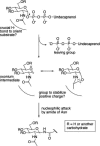Substrate specificity of bacterial oligosaccharyltransferase suggests a common transfer mechanism for the bacterial and eukaryotic systems
- PMID: 16641107
- PMCID: PMC1459022
- DOI: 10.1073/pnas.0509207103
Substrate specificity of bacterial oligosaccharyltransferase suggests a common transfer mechanism for the bacterial and eukaryotic systems
Abstract
The PglB oligosaccharyltransferase (OTase) of Campylobacter jejuni can be functionally expressed in Escherichia coli, and its relaxed oligosaccharide substrate specificity allows the transfer of different glycans from the lipid carrier undecaprenyl pyrophosphate to an acceptor protein. To investigate the substrate specificity of PglB, we tested the transfer of a set of lipid-linked polysaccharides in E. coli and Salmonella enterica serovar Typhimurium. A hexose linked to the C-6 of the monosaccharide at the reducing end did not inhibit the transfer of the O antigen to the acceptor protein. However, PglB required an acetamido group at the C-2. A model for the mechanism of PglB involving this functional group was proposed. Previous experiments have shown that eukaryotic OTases have the same requirement, suggesting that eukaryotic and prokaryotic OTases catalyze the transfer of oligosaccharides by a conserved mechanism. Moreover, we demonstrated the functional transfer of the C. jejuni glycosylation system into S. enterica. The elucidation of the mechanism of action and the substrate specificity of PglB represents the foundation for engineering glycoproteins that will have an impact on biotechnology.
Conflict of interest statement
Conflict of interest statement: No conflicts declared.
Figures




Similar articles
-
Increased efficiency of Campylobacter jejuni N-oligosaccharyltransferase PglB by structure-guided engineering.Open Biol. 2015 Apr;5(4):140227. doi: 10.1098/rsob.140227. Open Biol. 2015. PMID: 25833378 Free PMC article.
-
Desulfovibrio desulfuricans PglB homolog possesses oligosaccharyltransferase activity with relaxed glycan specificity and distinct protein acceptor sequence requirements.Glycobiology. 2011 Jun;21(6):734-42. doi: 10.1093/glycob/cwq192. Epub 2010 Nov 22. Glycobiology. 2011. PMID: 21098514
-
Structural insights from random mutagenesis of Campylobacter jejuni oligosaccharyltransferase PglB.BMC Biotechnol. 2012 Sep 24;12:67. doi: 10.1186/1472-6750-12-67. BMC Biotechnol. 2012. PMID: 23006740 Free PMC article.
-
Hijacking bacterial glycosylation for the production of glycoconjugates, from vaccines to humanised glycoproteins.J Pharm Pharmacol. 2015 Mar;67(3):338-50. doi: 10.1111/jphp.12321. Epub 2014 Sep 22. J Pharm Pharmacol. 2015. PMID: 25244672 Free PMC article. Review.
-
Structural Insight into the Mechanism of N-Linked Glycosylation by Oligosaccharyltransferase.Biomolecules. 2020 Apr 17;10(4):624. doi: 10.3390/biom10040624. Biomolecules. 2020. PMID: 32316603 Free PMC article. Review.
Cited by
-
Exploiting the Campylobacter jejuni protein glycosylation system for glycoengineering vaccines and diagnostic tools directed against brucellosis.Microb Cell Fact. 2012 Jan 25;11:13. doi: 10.1186/1475-2859-11-13. Microb Cell Fact. 2012. PMID: 22276812 Free PMC article.
-
Refined topology model of the STT3/Stt3 protein subunit of the oligosaccharyltransferase complex.J Biol Chem. 2017 Jul 7;292(27):11349-11360. doi: 10.1074/jbc.M117.779421. Epub 2017 May 16. J Biol Chem. 2017. PMID: 28512128 Free PMC article.
-
Picomolar inhibition of β-galactosidase (bovine liver) attributed to loop closure.Bioorg Med Chem. 2017 Oct 15;25(20):5194-5202. doi: 10.1016/j.bmc.2017.07.020. Epub 2017 Jul 13. Bioorg Med Chem. 2017. PMID: 28844803 Free PMC article.
-
Functional analysis of the Helicobacter pullorum N-linked protein glycosylation system.Glycobiology. 2018 Apr 1;28(4):233-244. doi: 10.1093/glycob/cwx110. Glycobiology. 2018. PMID: 29340583 Free PMC article.
-
StackGlyEmbed: prediction of N-linked glycosylation sites using protein language models.Bioinform Adv. 2025 Jun 28;5(1):vbaf146. doi: 10.1093/bioadv/vbaf146. eCollection 2025. Bioinform Adv. 2025. PMID: 40630498 Free PMC article.
References
-
- Linton D., Allan E., Karlyshev A. V., Cronshaw A. D., Wren B. W. Mol. Microbiol. 2002;43:497–508. - PubMed
-
- Szymanski C. M., Yao R., Ewing C. P., Trust T. J., Guerry P. Mol. Microbiol. 1999;32:1022–1030. - PubMed
-
- Young N. M., Brisson J. R., Kelly J., Watson D. C., Tessier L., Lanthier P. H., Jarrell H. C., Cadotte N., St Michael F., Aberg E., Szymanski C. M. J. Biol. Chem. 2002;277:42530–42539. - PubMed
Publication types
MeSH terms
Substances
LinkOut - more resources
Full Text Sources
Other Literature Sources
Molecular Biology Databases
Miscellaneous

